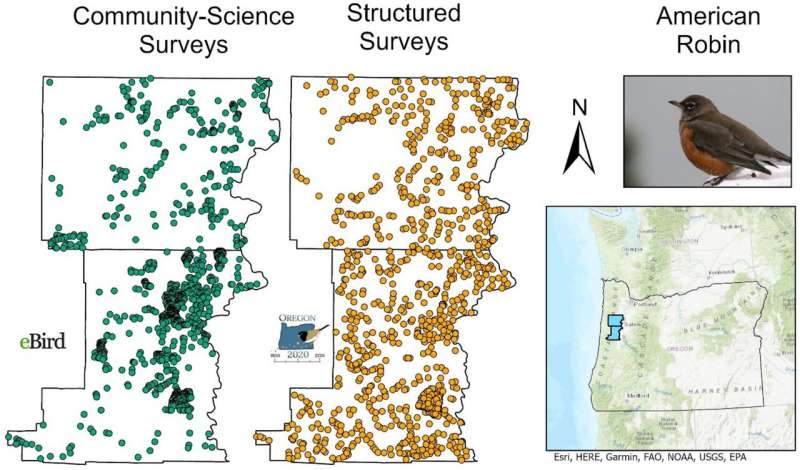This article has been reviewed according to Science X's editorial process and policies. Editors have highlighted the following attributes while ensuring the content's credibility:
fact-checked
peer-reviewed publication
trusted source
proofread
Study demonstrates the use of community science as a conservation tool for wildlife population estimation

Researchers have demonstrated a cost-effective method for estimating population size using a combination of freely available community science data and small numbers of structured surveys. The study, published in Scientific Reports, highlights the importance of incorporating structured survey data to enhance the accuracy of population estimates for songbird species.
Community science projects like eBird and Birdtrack provide vast biodiversity data. However, their effectiveness in estimating population size has been limited due to challenges accounting for imperfect detection and area sampled.
Researchers used structured distance-sampling surveys to model detection probability and calculate survey-specific detection offsets in community science models to address these issues and produce reliable population estimates from community science data.
Even small numbers of distance sampling surveys (which are much more rigorous and harder for community scientists to collect) can be used to effectively calibrate density and population models built with community science data.
"Our findings provide conservationists with a practical and cost-effective method for estimating density and population size. By integrating structured survey data with community science projects, we can improve the accuracy of population estimates, ultimately enhancing conservation efforts for songbird species and beyond," says Tyler Hallman, Lecturer in the School of Environmental & Natural Sciences and lead author of the study.
This innovative approach to population estimation holds promise for conservationists worldwide. It allows for fine-scale population estimation while leveraging the enormous information from millions of observations submitted by community scientists around the globe.
Complementary to this work, Hallman recently co-authored another study led by the Swiss Ornithological Institute and published in Ecology, which has developed a new way to analyze data from large community science databases, called integrated distance sampling (IDS) models. Both studies use distance sampling, which is based on the idea that the further an animal is from an observer, the less likely it is to be detected.
"When we go out and survey wildlife, we are almost always missing things. That's the nature of wildlife surveys. We generally detect a much higher proportion of the animals that are right next to us than those that are further away. This means that when you use raw counts (numbers reported that don't take this into account), which makes up the majority of community science data, you're generally undercounting what's actually out there."
Hallman added, "While statistical modeling may not excite most people, this study provides an innovative method of combining the strengths of wildlife surveys conducted by professionals and community science surveys submitted by the public to produce reliable population estimates, which are absolutely essential to conservation."
These two studies have the potential to significantly enhance the accuracy and availability of wildlife population estimates and could greatly augment the value of community science for conservation.
More information: Tyler A. Hallman et al, Supplemental structured surveys and pre-existing detection models improve fine-scale density and population estimation with opportunistic community science data, Scientific Reports (2024). DOI: 10.1038/s41598-024-61582-6
Marc Kéry et al, Integrated distance sampling models for simple point counts, Ecology (2024). DOI: 10.1002/ecy.4292
Journal information: Scientific Reports , Ecology
Provided by Bangor University


















